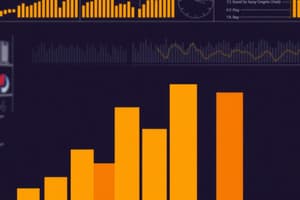Podcast
Questions and Answers
What is the primary objective of data collection in the context of market research?
What is the primary objective of data collection in the context of market research?
- To create detailed reports for internal use only.
- To gather information about potential customers and their preferences. (correct)
- To establish a research methodology for future projects.
- To analyze historical sales figures and identify trends.
According to the content, what is a key benefit of organizing collected data as soon as it becomes available?
According to the content, what is a key benefit of organizing collected data as soon as it becomes available?
- It ensures the data is easily accessible for analysis.
- It helps in identifying patterns and trends quickly.
- It reduces the risk of data loss or corruption.
- All of the above. (correct)
Which of the following is NOT a tip for gathering data effectively?
Which of the following is NOT a tip for gathering data effectively?
- Create more data by conducting experiments or surveys.
- Avoid challenging any assumptions made during the data collection process. (correct)
- Focus on data that aligns with a pre-determined message.
- Collect more data than you think you need.
What is a key characteristic of a well-designed research questionnaire?
What is a key characteristic of a well-designed research questionnaire?
Which of the following is a common method for conducting surveys?
Which of the following is a common method for conducting surveys?
Which of the following data collection methods is most suitable for gathering detailed insights from a small group of individuals?
Which of the following data collection methods is most suitable for gathering detailed insights from a small group of individuals?
What is the primary advantage of using interviews as a data collection method?
What is the primary advantage of using interviews as a data collection method?
Which of the following is an important guideline for designing a research questionnaire?
Which of the following is an important guideline for designing a research questionnaire?
What is one primary advantage of conducting personal interviews?
What is one primary advantage of conducting personal interviews?
Which of the following describes a drawback of telephone interviews compared to personal interviews?
Which of the following describes a drawback of telephone interviews compared to personal interviews?
What is the primary purpose of a focus group discussion?
What is the primary purpose of a focus group discussion?
Why is customer feedback particularly useful even after a business has started?
Why is customer feedback particularly useful even after a business has started?
What is a characteristic of interviews that use a standard set of questions?
What is a characteristic of interviews that use a standard set of questions?
What is the main goal of promotion in the marketing mix?
What is the main goal of promotion in the marketing mix?
What aspect of the Marketing Mix refers to the overall experience a customer has with a business?
What aspect of the Marketing Mix refers to the overall experience a customer has with a business?
Which of the following statements accurately describes the importance of packaging in the Marketing Mix?
Which of the following statements accurately describes the importance of packaging in the Marketing Mix?
What is the primary aim of brand strategy in a business?
What is the primary aim of brand strategy in a business?
What does the term "positioning" refer to in the context of the marketing mix?
What does the term "positioning" refer to in the context of the marketing mix?
According to the content, what is a key benefit of a well-defined brand strategy?
According to the content, what is a key benefit of a well-defined brand strategy?
Which aspect of the Marketing Mix is described as the "silent hero" of the marketing world?
Which aspect of the Marketing Mix is described as the "silent hero" of the marketing world?
What is the main idea behind the concept of "branding"?
What is the main idea behind the concept of "branding"?
What is the ideal duration for a focus group discussion?
What is the ideal duration for a focus group discussion?
How many participants are generally recommended for a focus group?
How many participants are generally recommended for a focus group?
Which of the following is NOT one of the 7 P's of the marketing mix?
Which of the following is NOT one of the 7 P's of the marketing mix?
In the context of focus groups, why is it important to ensure consistency in group composition?
In the context of focus groups, why is it important to ensure consistency in group composition?
What was the original number of P's in the marketing mix before it expanded to seven?
What was the original number of P's in the marketing mix before it expanded to seven?
Which role is essential for managing group dynamics during a focus group discussion?
Which role is essential for managing group dynamics during a focus group discussion?
What does 'Positioning' in the marketing mix refer to?
What does 'Positioning' in the marketing mix refer to?
What strategy should be used for conducting a focus group discussion?
What strategy should be used for conducting a focus group discussion?
What is the primary difference between a wholesaler and a retailer?
What is the primary difference between a wholesaler and a retailer?
Which of the following is NOT considered a stage of distribution of channels?
Which of the following is NOT considered a stage of distribution of channels?
Why is the use of a wholesaler often advantageous for small retailers?
Why is the use of a wholesaler often advantageous for small retailers?
What is the key characteristic of a 'direct-marketing' channel?
What is the key characteristic of a 'direct-marketing' channel?
Which of the following is an example of a 'service' as defined in the provided text?
Which of the following is an example of a 'service' as defined in the provided text?
Which of the following is a synonym for the distribution channel mentioned in the text?
Which of the following is a synonym for the distribution channel mentioned in the text?
What is the primary focus of the 'Place' element in the marketing mix?
What is the primary focus of the 'Place' element in the marketing mix?
Why is it important for a buyer of consumer goods to have thorough knowledge of the product?
Why is it important for a buyer of consumer goods to have thorough knowledge of the product?
Which of the following branding strategies is the most crucial in a market where customers are budget-conscious and distrustful?
Which of the following branding strategies is the most crucial in a market where customers are budget-conscious and distrustful?
What is the primary goal of a branding strategy that promotes 'Intentional' purpose?
What is the primary goal of a branding strategy that promotes 'Intentional' purpose?
Which of the following is a benefit of maintaining consistency in branding?
Which of the following is a benefit of maintaining consistency in branding?
Why is it important for marketers to be 'flexible' in their approach to branding?
Why is it important for marketers to be 'flexible' in their approach to branding?
Why is it important for employees to be 'well-versed' in the brand of their products?
Why is it important for employees to be 'well-versed' in the brand of their products?
According to the content, how does 'competitive awareness' impact branding strategy?
According to the content, how does 'competitive awareness' impact branding strategy?
Which of the following is NOT mentioned in the content as a necessary aspect of a successful branding strategy?
Which of the following is NOT mentioned in the content as a necessary aspect of a successful branding strategy?
According to the content, what is the key benefit of building customer loyalty?
According to the content, what is the key benefit of building customer loyalty?
Flashcards
Market Research
Market Research
The process of gathering, analyzing, and interpreting information about products or services for consumers.
Data Collection
Data Collection
The act of gathering information which is crucial for accurate research study results.
Data Gathering Techniques
Data Gathering Techniques
Methods used to collect information, including surveys, interviews, and focus groups.
Survey (Questionnaire)
Survey (Questionnaire)
Signup and view all the flashcards
Interview
Interview
Signup and view all the flashcards
Focus Group Discussion
Focus Group Discussion
Signup and view all the flashcards
Data Organization
Data Organization
Signup and view all the flashcards
Questionnaire Design Guidelines
Questionnaire Design Guidelines
Signup and view all the flashcards
Personal Interview
Personal Interview
Signup and view all the flashcards
Telephone Interview
Telephone Interview
Signup and view all the flashcards
Standard Set of Questions
Standard Set of Questions
Signup and view all the flashcards
Focus Group Discussion (FGD)
Focus Group Discussion (FGD)
Signup and view all the flashcards
Duration of FGD
Duration of FGD
Signup and view all the flashcards
Participants in FGD
Participants in FGD
Signup and view all the flashcards
Moderator in FGD
Moderator in FGD
Signup and view all the flashcards
Semi-structured discussions
Semi-structured discussions
Signup and view all the flashcards
Consistency in Group Composition
Consistency in Group Composition
Signup and view all the flashcards
Marketing Mix
Marketing Mix
Signup and view all the flashcards
Seven P’s of Marketing Mix
Seven P’s of Marketing Mix
Signup and view all the flashcards
Product
Product
Signup and view all the flashcards
Business Goods
Business Goods
Signup and view all the flashcards
Consumer Goods
Consumer Goods
Signup and view all the flashcards
Place
Place
Signup and view all the flashcards
Distribution Channel
Distribution Channel
Signup and view all the flashcards
Wholesaler
Wholesaler
Signup and view all the flashcards
Retailer
Retailer
Signup and view all the flashcards
Direct Marketing Channel
Direct Marketing Channel
Signup and view all the flashcards
Promotion
Promotion
Signup and view all the flashcards
People
People
Signup and view all the flashcards
Packaging
Packaging
Signup and view all the flashcards
Positioning
Positioning
Signup and view all the flashcards
Brand Name
Brand Name
Signup and view all the flashcards
Brand Strategy
Brand Strategy
Signup and view all the flashcards
Branding
Branding
Signup and view all the flashcards
Purpose
Purpose
Signup and view all the flashcards
Consistency
Consistency
Signup and view all the flashcards
Emotion in Branding
Emotion in Branding
Signup and view all the flashcards
Flexibility
Flexibility
Signup and view all the flashcards
Employee Involvement
Employee Involvement
Signup and view all the flashcards
Loyalty
Loyalty
Signup and view all the flashcards
Competitive Awareness
Competitive Awareness
Signup and view all the flashcards
Intentional Purpose
Intentional Purpose
Signup and view all the flashcards
Study Notes
Market Research
- Market research is the process of gathering, analyzing, and interpreting information about products or services offered to consumers.
- The goal is to understand potential consumers and improve offerings.
- Data collection is crucial to accurate market research.
- Inaccurate data collection leads to invalid results.
Data Collection Techniques
- Surveys (questionnaires) are common primary research tools.
- Interviews are a reliable way to gather information from target customers.
- Personal interviews and telephone interviews are common approaches.
- Personal interviews allow researchers to build relationships and clarify responses.
- Telephone interviews are less expensive and save time, but response rates are often lower.
- Focus group discussions (FGDs), moderated group interviews, or brainstorming sessions can generate and screen ideas and concepts.
- FGDs typically last 90-120 minutes and include 8 to 10 participants.
- A skilled moderator is essential for successful FGDs.
- It is important to consider consistency within the group's composition—avoid mixing dramatically different types of consumers in the same group.
Tips in Gathering Data
- Organize data as soon as it is available.
- Collect pertinent data relevant to the intended message, rather than gathering all data unnecessarily.
- Conduct experiments to collect data systematically.
- Challenge assumptions and set realistic expectations.
- Document notable or significant data.
Developing Brand Names/Branding Strategy
- A brand name is a unique identifier that distinguishes a company's products/services.
- A strong brand is a critical asset; it is the entire customer experience.
- A well-defined brand strategy promotes a popular brand to achieve goals and objectives.
- Brand strategy is a long-term plan linked to consumer needs, wants, emotional factors, and competition.
7 Ps of Marketing
- Product- encompasses any goods or services designed to fulfill customer needs and preferences.
- Place - represents the locations where buyers and sellers interact to exchange goods or services. This includes physical stores, virtual stores, and online shops. Distribution channels are involved.
- Price- reflects the value of a product or service exchanged for money.
- Promotion- includes all activities related to communicating the product, brand, or service to customers. This includes advertising, personal selling, promotions, direct marketing, and social media.
- People - refers to the individuals who represent and sell the product or service; they are crucial to successful marketing, especially in the services industry.
- Packaging - relates to the product's appearance and presentation to potential customers; good packaging is both attractive and cost-effective.
- Positioning - involves creating a distinct image of a product or service in the minds of the target audience.
Common Used Branding Strategies
- Purpose- Brands often make promises of quality and benefits but having a unique "significant purpose" is an essential differentiator.
- Consistency- Maintaining a consistent brand image avoids confusion and encourages customer loyalty.
- Emotion- Emotional engagement fosters a deeper connection with customers.
- Flexibility- Effective brands adapt to changing market conditions.
- Employee Involvement- Brands with empowered employees communicate and represent the product effectively to customers.
- Loyalty - Prioritize fostering positive customer relationships that influence future customers' perception of the brand.
- Competitive Awareness- Recognizing competition as a driver to improve brand value.
Studying That Suits You
Use AI to generate personalized quizzes and flashcards to suit your learning preferences.




